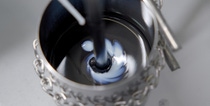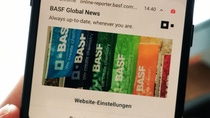Media
Joint News Release
BASF and KIT join forces in public funded project to investigate opportunities of multilayered anodes for lithium-ion batteries
- Knowledge transfer to foster coating technology in academia and to meet global customer demands
- Multilayered battery anodes exhibit higher energy density and significantly improve production efficiency
- Experts from BASF and Karlsruhe Institute of Technology (KIT) jointly elaborate the limits in combining differing formulations in one coating step
Electromobility is globally recognized as a decisive factor for achieving climate neutrality. High-performance lithium-ion batteries for electric vehicles play a key role to reach these goals. BASF is a leading player in the battery materials market focusing on high-performance cathode active materials (CAM) and anode binders for both standard tasks and tailored solutions, operating production facilities all around the globe. To enhance the performance of lithium ion-batteries in terms of increased range and reduced charging time, BASF collaborates with its academic network to further develop its smart materials and production processes with reduced CO2 footprint.
One potential solution for enhancing capacity and production efficiency of lithium-ion batteries is to subdivide electrodes into dedicated functional layers. For example, a thin primer layer below the actual active anode helps to improve adhesion performance. At the same time, the overall binder content is reduced, resulting in higher energy density. Application via simultaneous multilayer coating skips additional process steps that would increase costs and wastage. Both, academia and some first battery manufacturers are beginning to explore this approach. However, the potential range of coating formulations which can be combined is yet unknown.
To address this issue, BASF and Karlsruhe Institute of Technology (KIT) joined forces to investigate the formulation boundary conditions in multilayer battery coatings within a research project supported by public co-funding. This research project is part of the “Batterie 2020 Transfer” research cluster initiated by the German Federal Ministry of Education and Research. The goal of the joint project is to design a fully established formulation and coating model for multilayered battery coatings. While BASF specialists provide their formulation experience as well as know-how in application tests for defining the range of potentially combinable functional layers, KIT experts will implement those into and expand existing coating stability models.
“This joint research project is a great opportunity to deepen our knowledge in formulation and processing of battery coatings and to elaborate technical fundamentals for future battery product design. At BASF, we strongly encourage collaboration with external research partners in this exciting battery materials research area.” said Prof. Frank Kleine Jäger, Vice President Solids Formulation and Handling at BASF. “By applying several functional layers at once, we can meet the demanding requirements of tomorrow’s lithium-ion batteries.” explained Prof. Wilhelm Schabel, who leads the participating group “Thin Film Technology” at KIT. “With BASF as a complementary partner in this project, we are confident about extending the theories of multilayer coating by this major step,” added Dr. Philip Scharfer, co-head of the KIT research group.
“This joint research project is a great example of our profound expertise in the field of battery binders. And we are not standing still here: Knowing that electrode performance is a huge topic for our customers, we establish strategic development partnerships with other dedicated experts to serve our customers’ needs.” concluded Prof. Thomas Schiele, Vice President Adhesives, Fiber Bonding and Paper Coating Chemicals at BASF SE.
About BASF
At BASF, we create chemistry for a sustainable future. We combine economic success with environmental protection and social responsibility. More than 110,000 employees in the BASF Group contribute to the success of our customers in nearly all sectors and almost every country in the world. Our portfolio is organized into six segments: Chemicals, Materials, Industrial Solutions, Surface Technologies, Nutrition & Care and Agricultural Solutions. BASF generated sales of €59 billion in 2020. BASF shares are traded on the stock exchange in Frankfurt (BAS) and as American Depositary Receipts (BASFY) in the U.S. Further information at www.basf.com.
About KIT
Being “The Research University in the Helmholtz Association”, KIT creates and imparts knowledge for the society and the environment. It is the objective to make significant contributions to the global challenges in the fields of energy, mobility, and information. For this, about 9,600 employees cooperate in a broad range of disciplines in natural sciences, engineering sciences, economics, and the humanities and social sciences. KIT prepares its 23,300 students for responsible tasks in society, industry, and science by offering research-based study programs. Innovation efforts at KIT build a bridge between important scientific findings and their application for the benefit of society, economic prosperity, and the preservation of our natural basis of life. KIT is one of the German universities of excellence.
Media Contact BASF SE:
Communications Dispersions and Resins Europe | Birke Hinz
Phone: +49 621 60-49181
Email: birke.hinz@basf.com
Media Contact Karlsruhe Institute of Technology (KIT):
Strategic Corporate Development and Communications | Sandra Wiebe
Phone: +49 721 608-41172
Email: sandra.wiebe@kit.edu
P-21-352


